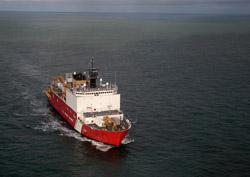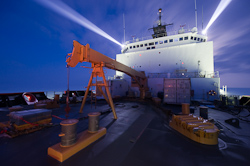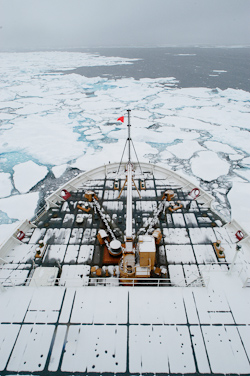Please note: You are viewing
the unstyled version of this website. Either your browser does not support CSS
(cascading style sheets) or it has been disabled. Skip
navigation.
DescriptionThe 420 foot long Coast Guard Cutter Healy is the United States' newest and most technologically advanced icebreaker. She is named after Coast Guard Captain Michael A. Healy and is homeported in Seattle, Washington.MissionHealy was designed as a polar research platform, and can conduct a wide range of at-sea research activities including geology, oceanography, sea-ice physics, and other scientific disciplines. As a Coast Guard cutter, Healy is also capable of supporting other potential missions in the polar regions, including logistics, search and rescue, ship escort, environmental protection, and enforcement of laws and treaties.CrewWilliam Rall is the current Captain of the Healy. A typical crew complement is 20 officers and 60 enlisted personnel. The crew is assigned to different departments, such as the operations department and the engineering department. The departments work together as a team to make sure the ship completes its missions efficiently and safely.Icebreaking capabilitiesHealy is designed to break 4 ½ feet of ice continuously at a speed of three knots but can break up to 8 feet of ice by "backing and ramming" the floes. Although Healy is capable of breaking very thick ice, rule number one in ice breaking is, "if possible, avoid the ice." This is simply because it takes longer, consumes more fuel, and produces more wear and tear on the ship when battering through the ice. The most efficient way to break through ice is to find the weakest points in the ice, such as existing cracks or open areas called "leads." When there are none, the ship will look for first year ice, which is often flat and 2-6 feet thick. As sea ice gets older it becomes considerably stronger, and changes color to a distinctive deep blue.ConstructionThe hull shape of the Healy is designed to maximize icebreaking by efficiently combining the forces of the ship’s forward motion, the downward pull of gravity on the bow, and the upward push on the stern due to its inherent buoyancy. Healy has other unique features designed for polar operations. Fuel tanks can carry over 1.2 million gallons of fuel to provide Healy with 60-150 days of endurance. A central hydraulic system operates cranes, boat hoists, and the anchor system. Healy also sometimes carries two HH-65A Dolphin helicopters to carry out scientific support, ice reconnaissance, cargo transfer, and search and rescue. The ship can comfortably operate in temperatures as low as -50 degrees F.ScienceHealy has 4,200' of laboratory space and berthing space for up to 50 scientists. The science community provided invaluable input on lab layouts and science capabilities during design and construction of the ship. The oceanographic winches and lab spaces give scientists the flexibility to conduct a wide range of research activities.Last updated: September 20, 2010 | |||||||||||||||||||
Copyright ©2007 Woods Hole Oceanographic Institution, All Rights Reserved, Privacy Policy. | |||||||||||||||||||



